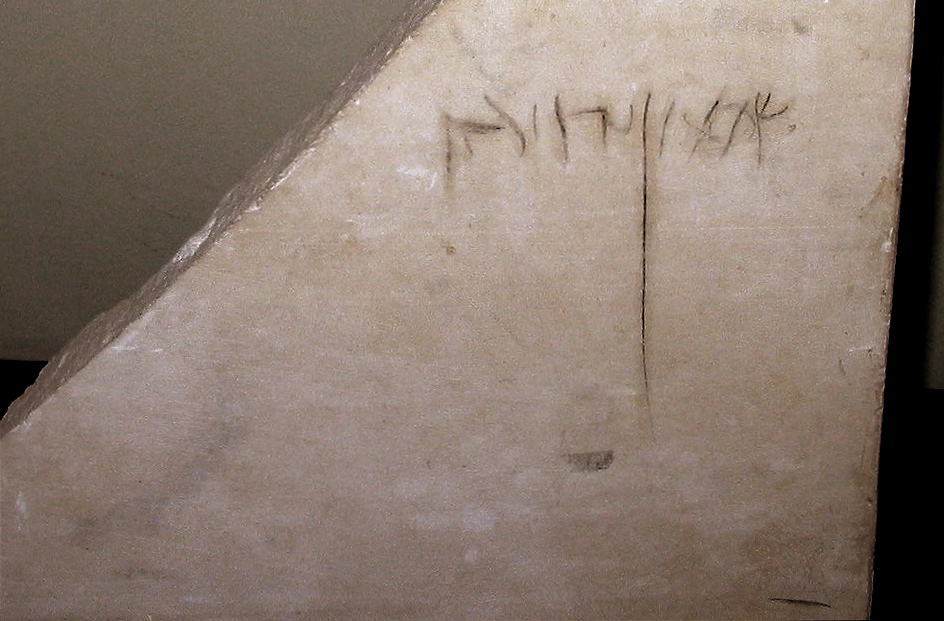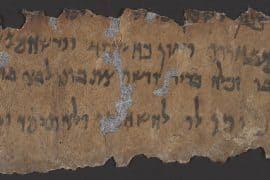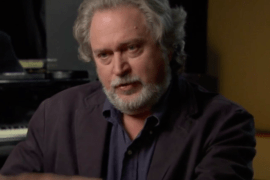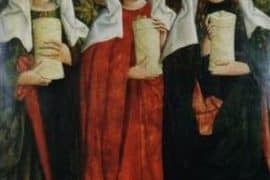In my 2006 book, The Jesus Dynasty, (pp. 235-237) I published a photo of an fragment of an 1st century CE limestone ossuary, or burial box, inscribed with the name “Simon bar Jonah,” a rare patronym used by Jesus one time in Matthew 16:17 to refer to Simon Peter:
And Jesus answered him, “Blessed are you, Simon Bar-Jona! For flesh and blood has not revealed this to you, but my Father who is in heaven.
The ossuary was found in 1953 on the Mt. of Olives by the late great Franciscan priest and archaeologist Bellarmino Bagatti. The fragment is now on display in the Franciscan museum at the second station of the Cross on the Via Dolorosa in Jerusalem. It is little known or discussed by Catholic pilgrims. The tomb in which the ossuary was found was part of in a fascinating necropolis of over a five hundred burial tombs that some scholars have identified, in whole or in part, with the early pre-70 CE Jewish-Christian community–that is, Jewish followers of Jesus who lived, died, and were buried as good Jews. This Aramaic father/son name is attested nowhere else, neither in inscriptions nor in literature. Further, the Simon, son of Jonah, ossuary was found just meters away from a tomb just outside of Bethany containing a single ossuary with two indviduals: Mary and Martha, and nearby another, inscribed Lazarus. For a fuller treatment, accessible to the non-specialist, see Jack Fingegan’s The Archaeology of the New Testament (Princeton: Princeton University Press, reprt 1979), pp. 359-375.

More recently, various scholars, including Emile Puech and most lately Stephan Pfann have questioned the suggestion by Bagatti and Milik (who was a bit more cautious) that the reading of this ossuary fragment is indeed: Shimon bar Jonah–presenting the possibility that Simon Peter, who is known by this rather unusual name in Matthew 16:17, may have been buried in Jerusalem rather than Rome. Pfann’s latest thoughts are found on his University of Holy Land Studies Web site here. Pfann reads the name of the father as BarZillai, the name of a priestly family known to us from the time of David and mentioned in Ezra 2:61.
In addition to Pfann’s alternative reading we now have the Corpus Inscriptionum Iudaeae/Palaestinae (edited by Hannah M. Cotton, et al.) Volume I: Jerusalem: Part 1. It contains 704 inscriptions, on ossuaries and other surfaces, that date to the area of Jerusalem in the 1st century BCE/CE. One of the editors, Haggai Misgav, prefers the reading: Shimon son of Lollia, a Latin name, noting that a second Latin name, Secunda or Verecunda, is found in the same burial complex. This name, Lollius or Lollianos was a short form of Alexandros. The editors of CIIP were apparently unaware of Pfann’s alternative suggestion.
I think the legendary martyrdom of Peter in Rome under Nero has scant historical support, despite the more recent claims of the Vatican to have verified his tomb, and the relics therein, under St. Peter’s Basilica, see “Pope Puts ‘St Peter’s Bones’ on Display at Vatican.” I agree with the work done by Nicola Denzy Lewis, a summary of which you can read here: “The Apostle Peter in Rome?”
With permission I reproduce this edited version of an article on this ossuary written in 1960 by F. Paul Peterson just when the discovery of the cemetery complex with its interesting clusters of names had caused a stir in certain quarters of the Protestant Christian world. For the most part the ossuary was marginalized and forgotten and a rather standard response prevailed–namely that these names are common, so they could have belonged to any Mary, Martha, Lazarus, or Simon son of Jonah of the period and region. Indeed, according to this way of thinking there must have been another family, with those very names, buried very near “another” Simon bar Jonah. I agree that there should be a “high threshold” of evidence to suggest positive identifications between known individuals in our literary records and material remains such as ossuary inscriptions. Nonetheless, given the rather narrow chronological window represented by limestone ossuary use in Jerusalem in the one hundred year period before its destruction in 70 CE such identifications with personages mentioned in our New Testament records are possible if not probably. I will give a lecture on this subject at the Biblical Archaeology Society, 15th Annual Bible and Archaeology Fest, November 16-18, 2012, Chicago, see here for details.
The following article article, written in 1953, is somewhat naive and tendentious, and it is very much a “period piece,” in terms of its style and approach. However, but it captures “a moment in time,” in terms of how the academic community, as well as different Christian communities, Catholic and Protestant, reacted to the discovery of the ossuary. The direct anecdotal references to a host of figures of that period, including Milik, Baggatti, Albright, Gleuck, and even Pope Pius XII are fascinating in their own right.
Peter’s Tomb Recently Discovered In Jerusalem
by F. Paul Peterson
Saint Peter’s Tomb: The Discovery of Peter’s Tomb in Jerusalem in 1953
While visiting a friend in Switzerland, I heard of what seemed to me, one of the greatest discoveries since the time of Christ—that Peter was buried in Jerusalem and not in Rome. The source of this rumor, written in Italian, was not clear; it left considerable room for doubt or rather wonder. Rome was the place where I could investigate the matter, and if such proved encouraging, a trip to Jerusalem might be necessary in order to gather valuable first hand information on the subject. I therefore went to Rome. After talking to many priests and investigating various sources of information, I finally was greatly rewarded by learning where I could buy the only known book on the subject, which was also written in Italian. It is called, “Gli Scavi del Dominus Flevit”, printed in 1958 at the Tipografia del PP. Francescani, in Jerusalem. It was written by P. B. Bagatti and J. T. Milik, both Roman Catholic priests. The story of the discovery was there, but it seemed to be purposely hidden for much was lacking. I consequently determined to go to Jerusalem to see for myself, if possible, that which appeared to be almost unbelievable, especially since it came from priests, who naturally because of the existing tradition that Peter was buried in Rome, would be the last ones to welcome such a discovery or to bring it to the attention of the world.
In Jerusalem I spoke to many Franciscan priests who all read, finally, though reluctantly, that the bones of Simon Bar Jona (St. Peter) were found in Jerusalem, on the Franciscan monastery site called, “Dominus Flevit” (where Jesus was supposed to have wept over Jerusalem), on the Mount of Olives. The pictures show the story. The first show an excavation where the names of Christian Biblical characters were found on the ossuaries (bone boxes). The names of Mary and Martha were found on one box and right next to it was one with the name of Lazarus, their brother. Other names of early Christians were found on other boxes. Of greatest interest, however, was that which was found within twelve feet from the place where the remains of Mary, Martha and Lazarus were found—the remains of St. Peter. They were found in an ossuary, on the outside of which was clearly and beautifully written in Aramaic, “Simon Bar Jona”.
The charcoal inscription reads: “Shimon Bar Yonah” which means “Simon [Peter] son of Jonah”.
Mat 16:17 And Jesus answered and said unto him, Blessed art thou, Simon Barjona: for flesh and blood hath not revealed it unto thee, but my Father which is in heaven.
I talked to a Yale professor, who is an archaeologist, and was director of the American School of Oriental Research in Jerusalem. He told me that it would be very improbable that a name with three words, and one so complete, could refer to any other than St. Peter.
But what makes the possibility of error more remote is that the remains were found in a Christian burial ground, and more yet, of the first century, the very time in which Peter lived. In fact, I have a letter from a noted scientist stating that he can tell by the writing that it was written just before the destruction of Jerusalem by Titus in 70 A.D.
I talked to priest Milik, the co-writer of this Italian book, in the presence of my friend, a Christian Arab, Mr. S. J. Mattar, who now is the warden of the Garden Tomb…This priest, Milik, admitted that he knew that the bones of St. Peter are not in Rome. I was very much surprised that he would admit that, so to confirm his admittance, I said, to which he also agreed, “There is a hundred times more evidence that Peter was buried in Jerusalem than in Rome.” This was something of an understatement, for he knew as I know that there is absolutely no evidence at all that Peter was buried in Rome
I have spoken on the subject to many Franciscan priests who either were or had been in Jerusalem, and they all agree that the tomb and remains of St. Peter are in Jerusalem. There was just one exception which is interesting and which only proves the point. The Franciscan priest, Augusto Spykerman, who was in charge of the semi-private museum inside the walls of old Jerusalem, by the site of the Franciscan Church of the Flagellation, was that exception. When I asked to see the museum, he showed it to the three of us, Mr. Mattar, who in addition to being warden of the Tomb of Christ, had been the manager of an English bank in Jerusalem, a. professional photographer and myself. But he told us nothing of the discovery. I knew that the evidence of Peter’s burial was there, for priests had told me that relics from the Christian burial ground were preserved within this museum. People who lived in Jerusalem all their lives and official guides who are supposed to know every inch of the city, however, knew nothing of this discovery, so well was it withheld from the public. I had asked an elderly official guide where the tomb of St. Peter was. He responded in a very profound and majestic tone of voice, “The Tomb of St. Peter has never been found in Jerusalem.” “Oh,” I said, “but I have seen the burial place of Peter with my own eyes.”…”What,” he replied, “you a foreigner mean to tell me that you know where the tomb of St. Peter is when I have been an official guide for thirty-five years and know every inch of ground in Jerusalem?” I was afraid that he would jump at my throat. I managed to calm him as I said, “But sir, here are the pictures and you can see the ossuary, among others, with Peter’s name in Aramaic. You can also see this for yourself on the Mount of Olives on the Franciscan Convent site called, “Dominus Flevit”. When I finished he slowly turned away in stunned amazement. A person who has seen this Christian burial ground and knows the circumstances surrounding the case could never doubt that this truly is the burial place of St. Peter and of other Christians. I, too, walked around in a dreamy amazement for about a week for I could hardly believe what I had seen and heard. Since the circulation of this article, they do not allow anyone to see this burial place.
Before things had gone very far, I had been quite discouraged for I could get no information from the many priests with whom I had talked. However, I continued questioning priests wherever I would find them. Finally one priest dropped some information. With that knowledge I approached another priest who warily asked me where I had acquired that information. I told him that a priest had told me. Then he admitted the point and dropped a little more information. It went on like that for some time until I got the whole picture, and I was finally directed to where I could see the evidence for myself. To get the story, it made me feel as though I had a bull by the tail and were trying to pull him through a key hole. But when I had gathered all the facts in the case, the priests could not deny the discovery of the tomb, but even confirmed it, though reluctantly. In fact, I have the statement from a Spanish priest on the Mount of Olives on a tape recorder, to that effect.
But here we were talking to this Franciscan priest in charge of the museum, asking him questions which he tried to evade but could not because of the information I had already gathered from the many priests with whom I had spoken. Finally after the pictures of the evidence were taken, which was nothing short of a miracle that he allowed us to do so, I complimented him on the marvelous discovery of the tomb of St. Peter in Jerusalem that the Franciscans had made. He was clearly nervous as he said, “Oh no, the tomb of St. Peter is in Rome.” But as he said that, his voice faltered, a fact which even my friend, Mr. Mattar, had noticed. Then I looked him squarely in the eyes and firmly said, “No, the tomb of St. Peter is in Jerusalem.” He looked at me like a guilty school boy and held his peace. He was, no doubt, placed there to hide the facts, but his actions and words, spoke more convincingly about the discovery than those priests who finally admitted the truth.
I also spoke to a Franciscan priest in authority at the priest’s printing plant within the walls of old Jerusalem, where their book on the subject was printed. He also admitted that the tomb of St. Peter is in Jerusalem. Then when I visited the Church of the Nativity in Bethlehem, I encountered a Franciscan monk. After telling him what I thought of the wonderful discovery the Franciscans had made, I asked him plainly, “Do you folks really believe that those are the remains of St. Peter?” He responded, “Yes we do, we have no choice in the matter. The clear evidence is there.” I did not doubt the evidence, but what surprised me was that these priests and monks believed that which was against their own religion and on top of that, to admit it to others was something out of this world. Usually a Catholic, either because he is brainwashed or stubbornly doesn’t want to see anything only that which he has been taught, will not allow himself to believe anything against his religion, much less to admit it to others. But there is a growing, healthy attitude among many Catholics, to “prove all things, hold fast to that which is good” as the Master admonished us all.
Then I asked, “Does Father Bagatti (co-writer of the book in Italian on the subject, and archaeologist) really believe that those are the bones of St. Peter?” “Yes, he does,” was the reply. Then I asked, “But what does the Pope think of all this?” That was a thousand dollar question and he gave me a million dollar answer. “Well,” he confidentially answered in a hushed voice, “Father Bagatti told me personally that three years ago he went to the Pope (Pius XII) in Rome and showed him the evidence and the Pope said to him, ‘Well, we will have to make some changes, but for the time being, keep this thing quiet’.” In awe I asked also in a subdued voice, “So the Pope really believes that those are the bones of St. Peter?” “Yes,” was his answer. “The documentary evidence is there, he could not help but believe.”
I visited various renowned archaeologists on the subject. Dr. Albright, of the John Hopkins University in Baltimore, told me that he personally knew priest Bagatti and that he was a very competent archaeologist. I also spoke with Dr. Nelson Glueck, archaeologist and president of the Hebrew Union College in Cincinnati, Ohio. I showed him the pictures found in this article, but being with him for only a few minutes I therefore could not show him the wealth of material that you have before you in this article. However, he quickly recognized the Aramaic words to be “Simon Bar Jona”. (Aramaic is very similar to Hebrew). I asked him if he would write a statement to that effect. He said to do so would cast a reflection on the competency of the priest J. T. Milik, who he knew to be a very able scientist. But he said that he would write a note. I quote,
“I regard Father J. T. Milik as a first class scholar in the Semitic field.” He added, “I do not consider that names on ossuaries are conclusive evidence that they are those of the Apostles.” Nelson Glueck
I quote this letter of Dr. Glueck because it shows that priest Milik is a competent archaeologist. As I have mentioned, I was only able to be with him for a few minutes and was not able to show him but a very small part of the evidence. Anyone, including myself, would readily agree with Dr. Glueck that if only the name Simon Bar Jona on the ossuary was all the evidence that was available it would not be conclusive evidence that it was of the Apostle Peter, though it would certainly be a strong indication. The story of the cave and the ossuaries and the regular cemetery just outside of the Convent site is this: It was a Roman custom that when a person had died and…when the body had decomposed, the grave would be opened. The bones would be placed in a small ossuary with the name of the person carefully written on the outside front. These ossuaries would then be placed in a cave as in the case of this Christian burial ground and thus making room for others. But this cave or burial place where the ossuaries were found and which was created and brought about through the natural and disinterested sequence of events, without any reason to change facts or circumstances, was a greater testimony than if there were a witness recorded, stating that Peter was buried there. And yet, even that is unmistakenly recorded in the three words in Aramaic of the ossuary, Simon Bar Jona. Herein, lies the greatest proof that Peter never was a Pope, and never was in Rome, for if he had been, it would have certainly been proclaimed in the New Testament. History, likewise, would not have been silent on the subject, as they were not silent in the case of the Apostle Paul. Even the Catholic history would have claimed the above as a fact and not as fickle tradition. To omit Peter as being Pope and in Rome (and the Papacy) would be like omitting the Law of Moses or the Prophets or the Acts of the Apostles from the Bible.
Dr. Glueck, being Jewish, and having been to Jerusalem, no doubt, is fully aware of the fact that for centuries the Catholic Church bought up what were thought to be holy sites, some of which did not stand up to Biblical description. For instance, the priests say that the tomb of Jesus is within the walls of the old Jerusalem, in a hole in the ground; whereas, the Bible says that the tomb where Jesus was laid was hewn out of rock and a stone was rolled in front and not on top of it. The Garden Tomb at the foot of Golgotha, outside the walls of old Jerusalem, meets the Biblical description perfectly. In fact, all those who were hated by the Jewish leaders, as Jesus was, could never have been allowed to be buried within the gates of the Holy City. The tomb where Jesus lay was made for Joseph of Arimathaea. His family were all stout and short of stature. In this burial place you can see to this day where someone had carved deeper into the wall to make room for Jesus who was said to be about six feet tall.
When Pope Pius XII declared the Assumption of Mary to be an article of faith in 1950, the Catholic Church in Jerusalem then quickly sold the tomb of Mary to the Armenian Church. Ex-priest Lavallo told me personally that there is another tomb of St. Mary in Ephesus. But the tomb of St. Peter is altogether different for they would rather that it never existed, and to buy or sell such a site would be out of the question. It fell upon them in this manner, as I was told by a Franciscan monk of the monastery of “Dominus Flevit”. One of their members was spading the ground on this site in 1953, when his shovel fell through. Excavation was started and there, a large underground Christian burial ground was uncovered. The initial of Christ in Greek was written there which would never have been found in a Jewish, Arab or pagan cemetery. By the structure of the writings, it was established by scientists that they were of the days just before the destruction of Jerusalem by Titus in 70 A.D. On the ossuaries were found many names of the Christian of the early Church. It was prophesied in the Bible that Jesus would stand on the Mount of Olives at His return to earth. You can see then, how the Christians would be inclined to have their burial ground on the Mount, for here also, had been a favorite meeting place of Jesus and His disciples. In all the cemetery, nothing was found (as also in the Catacombs in Rome) which resemble Arab, Jewish, Catholic or pagan practices. Dr. Glueck, being Jewish, is not fully aware, no doubt, that such a discovery is very embarrassing since it undermines the very foundation of the Roman Catholic Church. Since Peter did not live in Rome and therefore was not martyred or buried there, it naturally follows that he was not their first Pope…
As I have mentioned, I had a very agreeable talk with priest Milik, but I did not have the opportunity to see priest Bagatti while in Jerusalem. I wrote to him, however, on March 15, 1960, as follows: “I have spoken with a number of Franciscan priests and monks and they have told me about you and the book of which you are a co-writer. I had hoped to see you and to compliment you on such a great discovery, but time would not permit. Having heard so much about you and that you are an archaeologist (with the evidence in hand), I was convinced, with you, concerning the ancient burial ground that the remains found in the ossuary with the name on it, ‘Simon Bar Jona’, written in Aramaic, were those of St. Peter.” It is remarkable that in his reply he did not contradict my statement, which he certainly would have done if he honestly could have done so. “I was very much convinced with you – … that the remains found in the ossuary … were those of St. Peter.” This confirms the talk I had with the Franciscan monk in Bethlehem and the story he told me of Priest Bagatti’s going to the Pope with the evidence concerning the bones of St. Peter in Jerusalem. In his letter one can see that he is careful because of the Pope’s admonition to keep this discovery quiet. He therefore wrote me that he leaves the whole explanation of the Aramaic words, “Simon Bar Jona”, to priest Milik…In priest Bagatti’s letter one can see that he is in a difficult position. He cannot go against what he had written in 1953, at the time of the discovery of this Christian-Jewish burial ground, nor what he had said to the Franciscan monk about his visit to the Pope. However, he does raise a question which helps him to get out of the situation without altogether contradicting himself and at the same time putting a smoke screen around the truth. He wrote,
“Supposing that it is ‘Jona’ (on the ossuary) as I believe, it may be some other relative of St. Peter, because names were passed on from family to family. To be able to propose the identification of it with St. Peter would go against a long tradition, which has its own value. Anyway, another volume will come soon that will demonstrate that the cemetery was Christian and of the first century to the second century A.D. The salute in God most devoted P. B. Bagatti C. F. M.”
As I have shown, after the admonition of the Pope to “keep this thing quiet,” priest Bagatti leaves the interpretation of the whole matter to priest Milik who offers several suggestions but in the end declares that the original statement of priest Bagatti may be true—that the inscription and the remains were of St. Peter. It is also very interesting and highly significant that priest Bagatti, in his attempt to neutralize his original statement and the consternation the discovery had and would have if it were generally known, says in reference to the name Simon Bar Jona (St. Peter), “It may be some other relative of St. Peter, because names were passed on from generation to generation.” In other words he says that Peter’s name, Simon Bar Jona, could have been given him from a relative of the same name of generations before him, or, could belong to a relative generations after St. Peter…First of all, it could not refer to a relative before St. Peter for the Christian burial ground could only have come into being after Jesus began. His public ministry and had converts; and therefore, could not belong to a relative before Peter’s time, since only those who were converted through Christ’s ministry were buried there. Titus destroyed Jerusalem in 70 A.D. and left it desolate. Therefore, it is impossible that the inscription could refer to a relative after Peter’s time…
This ancient Christian burial ground shows that Peter died and was buried in Jerusalem, which is easily understandable since neither history nor the Bible tells of Peter’s having been in Rome. To make matters more clear, the Bible tells us that Peter was the Apostle to the Jews. It was Paul who was the Apostle to the Gentiles, and both history and the Bible tells of his being in Rome.









Comments are closed.